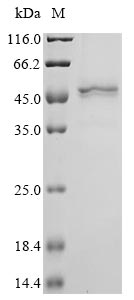Recombinant Hamster polyomavirus Major capsid protein VP1
CAT:
399-CSB-BP355947HBZ-03
Size:
20 µg
Price:
Ask
- Availability: 24/48H Stock Items & 2 to 6 Weeks non Stock Items.
- Dry Ice Shipment: No




Recombinant Hamster polyomavirus Major capsid protein VP1
- CAS Number: 9000-83-3
- UniProt: P03092
- Expression Region: 1-372aa
- Organism: Hamster polyomavirus (HaPyV) (Mesocricetus auratus polyomavirus 1)
- Target Sequence: MCKPLWKPCPKPANVPKLIMRGGVGVLDLVTGEDSITQIEAYLNPRMGQNKPGTGTDGQYYGFSQSIKVNSSLTADEVKANQLPYYSMAKIQLPTLNEDLTCDTLQMWEAVSVKTEVVGVGSLLNVHGYGSRSETKDIGISKPVEGTTYHMFAVGGEPLDLQGLVQNYNANYEAAIVSIKTVTGKAMTSTNQVLDPTAKAKLDKDGRYPIEIWGPDPSKNENSRYYGNFTGGTGTPPVMQFTNTLTTVLLDENGVGPLCKGDGLYLSAADVMGWYIEYNSAGWHWRGLPRYFNVTLRKRWVKNPYPVTSLLASLYNNMLPTIEGQPMEGEAAQVEEVRIYEGTEAVPGDPDVNRFIDKYGQQHTKPPAKPAN
- Tag: N-terminal 10xHis-tagged and C-terminal Myc-tagged
- Source: Baculovirus
- Field of Research: Immunology
- Assay Type: Developed Protein
- Relevance: Forms an icosahedral capsid with a T=7 symmetry and a 40 nm diameter. The capsid is composed of 72 pentamers linked to each other by disulfide bonds and associated with VP2 or VP3 proteins. Interacts with sialic acids on the cell surface to provide virion attachment to target cell. Once attached, the virion is internalized by endocytosis and traffics to the endoplasmic reticulum. Inside the endoplasmic reticulum, the protein folding machinery isomerizes VP1 interpentamer disulfide bonds, thereby triggering initial uncoating. Next, the virion uses the endoplasmic reticulum-associated degradation machinery to probably translocate in the cytosol before reaching the nucleus. Nuclear entry of the viral DNA involves the selective exposure and importin recognition of VP2/Vp3 nuclear localization signal. In late phase of infection, neo-synthesized VP1 encapsulates replicated genomic DNA in the nucleus, and participates in rearranging nucleosomes around the viral DNA.
- Purity: Greater than 85% as determined by SDS-PAGE.
- Activity: Not Test
- Length: Full Length
- Form: Liquid or Lyophilized powder
- Buffer: If the delivery form is liquid, the default storage buffer is Tris/PBS-based buffer, 5%-50% glycerol. If the delivery form is lyophilized powder, the buffer before lyophilization is Tris/PBS-based buffer, 6% Trehalose, pH 8.0.
- Reconstitution: We recommend that this vial be briefly centrifuged prior to opening to bring the contents to the bottom. Please reconstitute protein in deionized sterile water to a concentration of 0.1-1.0 mg/mL.We recommend to add 5-50% of glycerol (final concentration) and aliquot for long-term storage at -20℃/-80℃. Our default final concentration of glycerol is 50%. Customers could use it as reference.
- Molecular Weight: 44.7kDa
- Storage Conditions: The shelf life is related to many factors, storage state, buffer ingredients, storage temperature and the stability of the protein itself. Generally, the shelf life of liquid form is 6 months at -20℃/-80℃. The shelf life of lyophilized form is 12 months at -20℃/-80℃.
